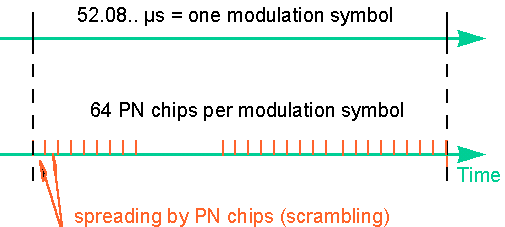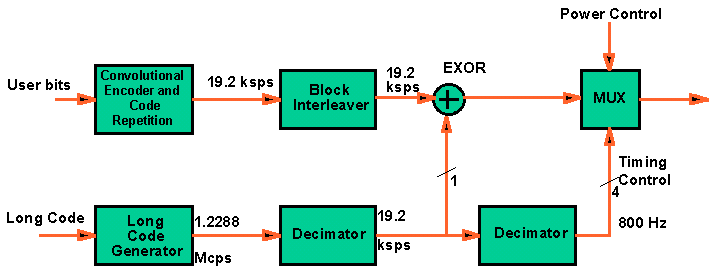
IS95: Forward link
The Forward IS95 Channel consists of several code channels:
- the Pilot Channel,
The Pilot tone is always transmitted by the base station on each active Forward CDMA Channel. It is an unmodulated spread spectrum signal (i.e., it does not contain spreading by the short Walsh Hadamerd code). The pilot tone is a PN-sequence, which is used for synchronization.
- a Sync Channel, operating at a fixed rate of 1200 bit/s
- up to seven Paging Channels, (at a fixed rate of 9600 or 4800 bit/s.) and
- a number of Forward Traffic Channels (at 9600, 4800, 2400, and 1200 bit/s).
Each of these code channels is orthogonally spread by the appropriate Walsh function and is then spread by a quadrature pair of (maximum length) PN sequences at a fixed chip rate of 1.2288 Mchips/sec.
Multiple Forward CDMA Channels may be used within a base station in a frequency division multiplexed manner.
Error protection coding
All channels except the pilot tone are convolutionally at rate 1/2.
This encoder generates two code symbols for each user data code symbol.
By means of EXOR-ing (modulo-2 addition) of selected taps of the time-delayed input data sequence.
(See also reverse channel for diagram of a convolutional encoder.)
The generator functions describing the selection of these taps are
- g0 = 753 (octal) and
- g1 = 561 (octal).
The length of the tapped delay is 8, i.e., the encoder uses 9 different input symbols for each output.
(Constraint length K = 9).
Walsh Code Spreading
Every channel is EXOR-ed with a Walsh function, at a chip rate of 1.2288 Mchips / second. This provides orthogonal Code Division Multiplexing. The length of the Walsh function is 64, so 64 orthogonal codes exist. The Walsh function has a period of 52.083... ms,, that is, 64 divided by the chipo rate of 1.2288 Mchip/s. This period equals one Forward Traffic Channel modulation symbol.
Code number zero (64 consecutive "zeros") is assigned to the Pilot Channel. This means that the pilot tone are transmitted is multiplied by a constant "-1", so it does not exhibit Walsh spreading.
If the Sync Channel is present, it has code number 32 (32 "zeros" followed by 32 "ones"). Paging Channels, if present, have codes 1 through 7.
PN spreading
After Walsh CDMA spreading, every signal is modulated by a quadrature sequence of length 215= 32768. This sequence is called the pilot PN sequence.
It is generated from
- Inphase:
PI(x) = x15 + x13 + x9 + x8 + x7 + x5 + 1,
and
- Quadrature:
PI(x) = x15 + x12 + x11 + x10 + x6 + x5 + x4 + x3 + 1.
The maximum length LFSR (linear feedback shift register) sequence has length 215 - 1
(because linear systems would be stuck if the all zero state would be entered).
A "zero" is added after 14 consecutive "zeros", to obtain the I and Q pilot PN sequences of period 215.
The period of the pilot sequence period is 32768 chips over 1228800 chips/s, which equals 26.666... ms. This has been chosen such that 75 pilot PN sequence repetitions occur every 2 seconds.
| 
| 64 chips of PN spreading scramble each channel.
|
| 
| User bits are convolutionally encoded and interleaved.
|







